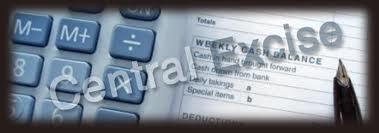- About Central Excise
- Jurisdiction
- Functions
- Office Bearers & Contact Details
- Employee Management System
- Informants
- FAQ
- Overview of Central Excise
- C B E C
- Citizen Charter in English
- Acts
- Rules
- Case Laws
- Tariffs
- Circulars & Instructions
- Notifications
- Forms
- E-payment

Brief History and Developments
Central Excise duty is an indirect tax levied on goods manufactured in India. The tax is administered by the Central Government under the authority of Entry 84 of the Union List (No. 1) under Seventh schedule read with Article 246 of the Constitution of India.
The Central Excise duty is levied in terms of Central Excise Act, 1944 and the rates of duty, ad valorem or specific, are prescribed under the Schedule I and II of the Central Excise Tariff Act, 1985. The taxable even under the Central Excise law is 'manufacture' and the liability of Central Excise duty arises as soon as the goods are manufactured . The Central Excise Officers are also entrusted to collect other types of duties levied under Additional Duties of Excise (Goods of Special Important) Act, Additional Duties of Excise (Textiles and Textile Articles) Act, Cess etc.
Till 1969, there was physical control system wherein each clearance of manufactured goods from the factory was done under the supervision of the Central Excise Officers. Introduction of Self-Removal procedure was a watershed in the excise procedures. In 1969, the assessees were allowed to quantify the duty on the basis of approved classification list and the price list and clear the goods on payment of appropriate duty.
In 1994, the gate pass system gave way to the invoice-based system, and all clearances are effected on manufacturer's own invoice. Another major change was brought about in 1996, when the Self-Assessment system was introduced. This system is continuing today also. The assessee himself assesses his Tax Return and the Department scrutinizes it or conducts audit to ascertain correctness of the duty payment. Even the classification and value of the goods were to be merely declared by the assessee instead of obtaining approval of the same from the Department.
In 2000, the fortnightly payment of duty system was introduced for all commodities, an extension of the monthly payment of duty system introduced the previous year for Small Scale Industries.
In 2001, new Central Excise (No.23) Rules, 2001 have replaced the Central Excise Rules, 1944 with effect from 1st July, 2001. Other rules have also been notified namely, CENVAT Credit Rules, 2001, Central Excise Appeals rules, 2001 etc. With the introduction of the new rules several changes have been effected in the procedures. The new procedures are simplified. There are less numbers of rules, only 33 as compared to 234 earlier. Classification declaration and Price declarations have also been dispensed with, the CENVAT declaration having been earlier dispensed with in 2000 itself.
Administration of Central Excise
The Central Excise law is administered by the Central Board of Excise and Customs (CBEC or Board) through its field offices, the Central Excise Commissionerates. For this purpose, the country is divided into 23 Zones and a Chief Commissioner of Central Excise heads each Zone. There are total 92 Commissionerates in these Zones headed by Commissioners of Central Excise. Divisions and Ranges are the subsequent formations, headed by Deputy/Assistant Commissioners of Central Excise and Superintendents of Central Excise, respectively.
For enforcing the Central Excise law and collection of Central Excise duty the following types of procedures are being followed by the Central Excise Department
- Physical Control - Applicable to cigarettes only. Here assessment precedes clearance which takes place under the supervision of Central Excise officers
- Self-Removal Procedure - Applicable to all other goods produced or manufactured within the country. Under this system, the assessee himself determines the duty liability on the goods and clears the goods.